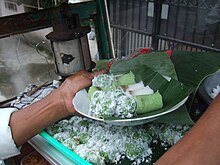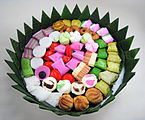 A plate of klepon A plate of klepon | |
| Alternative names | Onde-onde (Brunei, Malaysia, Singapore, Sumatra, Sulawesi) Kalalapun (Borneo, Indonesia) |
|---|---|
| Type | Snack |
| Place of origin | Indonesia |
| Region or state | Java Sulawesi (southern) |
| Associated cuisine | Indonesia, Brunei, Malaysia and Singapore |
| Main ingredients | Rice cake, palm sugar (gula jawa/merah/melaka), grated coconut |
| Variations | Rainbow klepon |
| Similar dishes | bua loi, mont lone yay baw, Khanom tom, tangyuan, modak |
Klepon (Javanese: ꦏ꧀ꦭꦼꦥꦺꦴꦤ꧀, romanized: klêpon) or kelepon or kalalapun, also known outside Java as onde-onde and buah melaka, is a sweet rice cake ball filled with molten palm sugar and coated in grated coconut. Of Javanese origin, the green-coloured glutinous rice balls are one of the popular traditional kue in Indonesian cuisine.
Ingredients and cooking method
Klepon is a boiled rice cake filled with liquid palm sugar (gula jawa/merah/melaka) and coated in flaked coconut. The dough is made from glutinous rice flour, sometimes mixed with tapioca (or sweet potato alternatively) and a paste made from the leaves of the pandan or dracaena plants (daun suji) — whose leaves are used widely in Southeast Asian cooking — giving the dough its green colour.
The small pieces of palm sugar are initially solid when inserted into the glutinous rice dough and rolled into balls. The balls are subsequently boiled, which melts the palm sugar and creates a sweet liquid inside the balls' cores. Skill is involved in ensuring that the liquid does not leak out of the final product. The balls are finally rolled in shredded coconut, adhering to the sticky surface of the glutinous rice dough.
Klepon are ideally left to cool for some time before consumption to prevent burning from the hot liquid palm sugar. They are traditionally served in banana leaves, usually in sets of four or ten balls; plastic packaging is also used in recent times.
Names

Klepon, meaning 'animal's ovary', is the Javanese name for this kue. In Kalimantan, especially in Banjar cultural area in South Kalimantan, it is known as kalalapun, which clearly derived from Javanese klepon.
In other parts of Indonesia, such as in Sulawesi, Minangkabau region in West Sumatra, and in neighbouring Malaysia, it is mainly known as onde-onde. In Malacca, it is also known by the name buah melaka (Indian gooseberry). In Java, onde-onde refers to the Chinese jian dui, a rice cake ball coated with sesame seeds and filled with sweet green bean paste. Although popular in Indonesia and neighboring areas, klepon originated in Java.
The dish is also called klepon in the Netherlands, due to its colonial ties with Java.
History

The ingredients for klepon, i.e. coconut, palm sugar, and glutinous rice flour are commonly familiar in traditional Indonesian kue making since ancient times, especially in Java. The oldest written evidence that mentions the klepon is in the Surakarta heritage manuscript, namely Serat Centhini, which was written in the early 19th century. Klepon was part of a treat in Javanese royal banquets. It is also served during traditional celebration rituals such as slametan parties. It is usually served with several other traditional foods or snacks in one tray.
In the 1950s, klepon was introduced to the Netherlands by Indo immigrants and is readily available throughout the country in toko shops, Dutch or Chinese Indonesian restaurants, and supermarkets.
In Java, klepon, along with getuk and cenil, are often eaten as morning or afternoon snacks. They are categorised as jajan pasar (market snacks) in traditional markets and villages and kue basah (moist kue) in urban areas due to Chinese influence in naming.
Variants and similar dishes

Traditional klepon or onde onde is quite homogeneous in Indonesia, Malaysia and Singapore. Still, new recipes have been developed: some modern variants replace the rice flour with yam or sweet potato (Indonesian: ubi) dough, the liquid palm sugar filling with chocolate, or the grated coconut with grated cheddar cheese. Colourful klepon has also been created using potato-based dough and food colouring to make it more appealing to children.
Klepon is quite similar to Kue putu, with the difference in its shape, texture and the flour being used — klepon uses glutinous rice flour, while kue putu uses common rice flour. Klepon has somewhat a chewy sticky texture similar to mochi, and kue putu has a soft yet crumbly texture akin to cake. Klepon is spherical, while kue putu is tubular, shaped using a hollow bamboo tube.
Traditional klepon ingredients has been used in cake and pastries baking technique to create a fusion of traditional and contemporary dessert. For example klepon cake, which is klepon-flavoured cake with pronounced pandan and coconut aroma. Cupcakes using onde onde ingredients are another recent variation on the dish. There is also klepon-flavoured instant coffee in Indonesia, which combine pandan and coconut flavour with palm sugar into coffee.
The Indian dish paan ladoo resembles klepon, but uses betel leaves (paan) instead of pandan.
See also
References
- Goldstein, Darra (2015). The Oxford Companion to Sugar and Sweets. Oxford Companions Series. Oxford University Press. p. 868. ISBN 978-0-19-931339-6. Retrieved 21 July 2024.
- ^ "Traditional Dessert From Java". TasteAtlas. 22 January 2018. Retrieved 21 July 2024.
- ^ Rhein Fathia; Septi Rinasusanti, eds. (2013). 101 Kue Nusantara (in Indonesian). Puspa Swara. p. 57. ISBN 9786028453684.
- ^ Geneeskundig tijdschrift voor Nederlandsch-Indië, Volume 75 (in Dutch). G. Kolff & Company. 1935.
- ^ "Singaporean Desserts with Gula Melaka: Ondeh Ondeh and Kueh Kosui". Asia Society. Retrieved 3 January 2024.
- ^ "Arti kata klepon - Kamus Besar Bahasa Indonesia (KBBI) Online". kbbi.web.id (in Indonesian). Retrieved 8 January 2024.
- ^ Sri Owen (2014). Sri Owen's Indonesian Food. Pavilion Books. p. 69. ISBN 9781909815476.
- Heinz Von Holzen (2014). A New Approach to Indonesian Cooking. Marshall Cavendish International Asia Pte Ltd. p. 191. ISBN 9789814634953.
- Salmah (2 June 2017). "Takjil: Bulat Manis Pecah di Lidah". Tribunnews Banjarmasin Post.
- "Sering Didebatkan, Apa Beda Klepon dan Onde-onde?". kumparan (in Indonesian). Retrieved 8 January 2024.
- Walker, Kylie (18 September 2019). "The stirring story of how rich, sweet palm sugar is made". SBS Food. Retrieved 16 July 2024.
- ^ Annemarie Cottaar, ed. (2006). Indisch leven in Nederland Volume 2170 from Meulenhoff editie (in Dutch). J.M. Meulenhoff. ISBN 9789029075503.
- Wijaya, Yana Gabriella (22 July 2020). "Sejarah Klepon, Kue Tradisional yang Tak Hanya Ada di Jawa". Kompas.com.
- Lukmana, Danang (13 October 2022). "Sejarah Klepon: Si Bulat yang Nyos di Mulut". Nibble (in Indonesian). Retrieved 21 July 2024.
- "Cara Membuat Kue Klepon Pandan Isi Gula Merah". Resep Nasional (in Indonesian). 19 March 2022.
- "Klepon Ubi Jalar". Cookpad (in Indonesian).
- "Klepon isi Coklat". Cookpad (in Indonesian).
- "Klepon Keju". Cookpad (in Indonesian).
- "Klepon Kentang Warna-warni" (in Indonesian). 24 February 2009.
- Mentari, Alma Erin (26 December 2020). "Resep Klepon Cake, Pilihan Dessert Audrey MasterChef Indonesia" (in Indonesian). KOMPAS.com. Retrieved 2 August 2024.
- Iffah Nadhirah Osman (24 September 2016). "Cupcakes with a local twist". The Urban Wire. Retrieved 3 October 2016.
- "ABC Klepon | Kapal Api Store: Official E-Commerce PT Kapal Api Global". www.kapalapistore.com. Retrieved 2 August 2024.
| Dishes |
| ||||||||
|---|---|---|---|---|---|---|---|---|---|
| Snacks |
| ||||||||
| Drinks |
| ||||||||
| Common dishes |
| ||||||||||||
|---|---|---|---|---|---|---|---|---|---|---|---|---|---|
| Snacks |
| ||||||||||||
| Desserts | |||||||||||||
| Drinks |
| ||||||||||||
| Condiments | |||||||||||||
